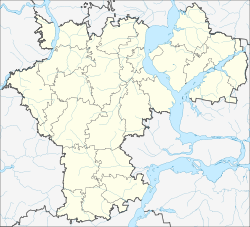Barysch
| city
Barysch
Barysh
|
||||||||||||||||||||||||||||||||||||||||||
|
||||||||||||||||||||||||||||||||||||||||||
|
||||||||||||||||||||||||||||||||||||||||||
| List of cities in Russia | ||||||||||||||||||||||||||||||||||||||||||
Barysch ( Russian Бары́ш ) is a city in the Ulyanovsk Oblast ( Russia ) with 17,149 inhabitants (as of October 14, 2010).
geography
The city is located about 140 km southwest of the oblast capital Ulyanovsk on the right bank of the Barysch river of the same name , a right tributary of the Sura, which flows into the Volga .
Barysch is administratively directly subordinate to the Oblast and at the same time the administrative center of the Rajon of the same name .
The city is located on the Moscow - Ryazan - Rusajewka - Syzran - Samara railway line (794 km from Moscow).
history
The first officially mentioned localities in the area of today's city emerged in the second half of the 17th century. An economic boom came with the establishment of a cloth weaving mill in the village of Gurjewka in 1826. In 1848 a paper mill was built in the village of Kurojedowo , later Troizko-Kurojedowo . By the end of the 19th century, more factories were built, so that the area became the most economically developed area of the otherwise agricultural Simbirsk governorate .
On September 7, 1928, Troitsko-Kurojedowo became the urban-type settlement named after the river Barysch ; Gurjewka also received this status. During the Second World War , more textile factories were relocated to Barysch from Vitebsk and Gomel in the western part of the Soviet Union .
On December 22nd, 1954, Barysch received city rights when the two settlements were merged.
Population development
| year | Residents | Remarks |
|---|---|---|
| 1939 | 12,497 | (of which Barysch 6,093, Gurjewka 6,404) |
| 1959 | 17,909 | |
| 1970 | 20,792 | |
| 1979 | 20,288 | |
| 1989 | 20,213 | |
| 2002 | 18,902 | |
| 2010 | 17,149 |
Note: census data
Culture and sights
In Barysch the Trinity Church ( Троицкая церковь / Troitskaja zerkow) from 1754 is preserved (restored 1991-1993), as well as the factory and administration building of the Gurjewka weaving mill from 1826 and the mansion of the founder D. Krotkow.
The city has a local and historical museum .
Nearby, on the upper reaches of the Malaya Swijaga river , the 176-hectare Akschaut Park ( Akschautski park ), founded in 1848, features a number of tree species that are atypical for the area.
economy
The machine factory Reduktor AG (gear manufacturer), several textile, a paper and a furniture factory as well as companies in the construction and food industries are located in Barysch .
sons and daughters of the town
- Olga Abramova (* 1988), biathlete
Individual evidence
- ↑ a b Itogi Vserossijskoj perepisi naselenija 2010 goda. Tom 1. Čislennostʹ i razmeščenie naselenija (Results of the All-Russian Census 2010. Volume 1. Number and distribution of the population). Tables 5 , pp. 12-209; 11 , pp. 312–979 (download from the website of the Federal Service for State Statistics of the Russian Federation)
Web links
- City administration website (Russian)
- Barysch on mojgorod.ru (Russian)




